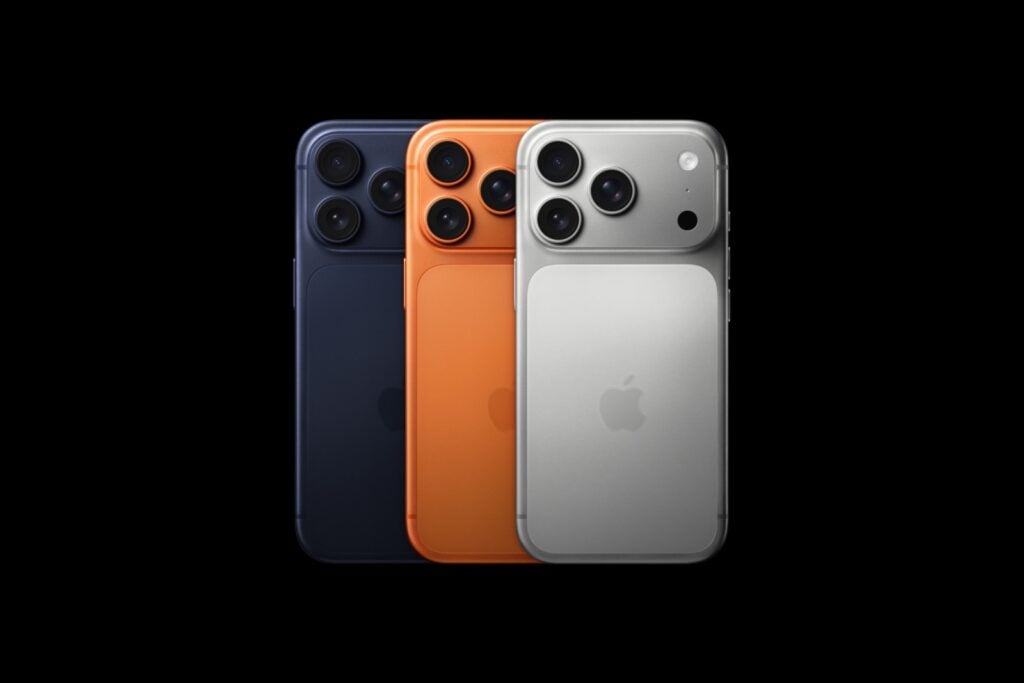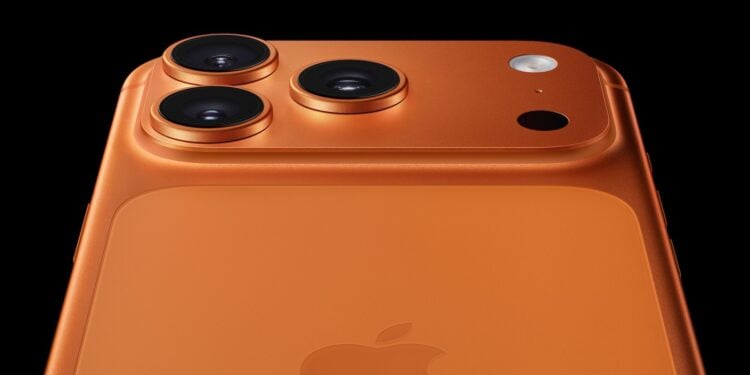The iPhone 17 Pro and iPhone 17 Pro Max feature a new camera design that significantly differentiates them from their predecessors. For the first time, Apple is using a camera platform that extends almost across the entire back. This houses a redesigned triple camera system with 48 megapixels per lens, an extended zoom range, and improved sensors. Combined with new video features and a redesigned front camera, the iPhone 17 Pro becomes the most versatile photo and video device in the iPhone lineup.
For years, the camera has been one of the most important reasons for buying an iPhone. With the iPhone 17 Pro, Apple goes a step further, optimizing both hardware and software. In addition to the new plateau design, the Fusion telephoto lens is particularly striking, offering significantly more zoom options than its predecessors. The system is complemented by powerful image processing features and professional video tools.
The new camera platform
The iPhone 17 Pro replaces the traditional camera module with a plateau that takes up almost the entire back. This surface houses three cameras: a wide-angle, ultra-wide-angle, and a telephoto lens, each with 48 megapixels. To the right of these are a LiDAR scanner and the adaptive True Tone flash. The larger surface area accommodates sensors with greater light sensitivity, which directly impacts image quality in difficult lighting conditions.

Telephoto lens with up to 200 mm focal length
The telephoto lens is the biggest innovation in the camera system. It brings several improvements:
- 48-megapixel resolution, a significant increase over the 12 megapixels of the iPhone 16 Pro
- 4x zoom at 100mm with full 48-megapixel resolution
- 8x zoom at 200 mm with 12 megapixels
- 56 percent larger sensor for better low-light shots
- Hybrid Focus Pixels, autofocus, optical image stabilization with 3D sensor shift
- Tetraprism design, which was introduced last year
- Digital zoom up to 40x
This significantly expands the iPhone 17 Pro's zoom range. While it doesn't reach the 100x magnification of some Android smartphones, it offers a clear upgrade compared to older iPhones.
Wide-angle lens as standard lens
The Fusion main lens remains the basis for most shots. Here, too, Apple relies on 48 megapixels and offers various capture formats:
- 24 or 48 megapixels at 24 mm focal length
- 12 megapixels in 2x telephoto mode with 48 mm focal length
- Aperture f/1.78
- 100 percent focus pixels
- Second-generation optical image stabilization with sensor shift
Ultra wide angle for panorama and macro
The Fusion Ultra Wide captures wide scenes with a 13 mm focal length and a 120-degree field of view. It features 48 megapixels, an f/2.2 aperture, and Hybrid Focus Pixels. In addition to classic landscape shots, it supports macro shots with full 48-megapixel resolution.
LiDAR scanner and True Tone flash
To the right of the camera platform sits an adaptive True Tone flash and a LiDAR scanner. The scanner provides more precise depth detection and improves both portraits and autofocus in low-light conditions.
Software features for photos
Apple integrates all the well-known photo features of recent years into the iPhone 17 Pro and complements them with improvements:
- Photonic Engine for detailed images in low light
- Deep Fusion for texture and detail enhancements in medium lighting
- Smart HDR 5 for better contrast, lighting conditions and skin tones
- Portrait mode with focus and depth control, even after shooting
- Portrait lighting with effects such as studio or high-key mono
- Night mode for very dark scenes
- Panorama shots up to 63 megapixels
- Photo styles with new “Bright” option
- Spatial photos and videos for Apple Vision Pro
- ProRAW for professional image editing
- Lens correction for ultra-wide-angle shots
- Automatic image stabilization
- Burst mode for fast action shots
Video features for professionals
The iPhone 17 Pro also improves video performance. Supported are:
- 4K Dolby Vision with up to 120 fps
- ProRes RAW recordings and Apple Log 2 for more flexibility in editing
- Genlock synchronization for professional film sets
- Dual Capture, i.e. simultaneous recordings with front and rear cameras in 4K Dolby Vision at 30 fps
- Cinema mode in 4K Dolby Vision at 30 fps
- Action mode with 2.8K Dolby Vision at 60 fps for better stabilization
- Spatial video recordings at 1080p at 30 fps
- Slow motion in 1080p at up to 240 fps or 4K Dolby Vision at 120 fps
- Macro video including slow motion and time lapse
- Time-lapse recordings
- QuickTake for spontaneous clips
- Digital zoom up to 15x for videos
- Continuous autofocus
- Cinematic video stabilization
- Audio mix and wind noise suppression
Revised front camera
The front camera of the iPhone 17 Pro is completely new:
- 18-megapixel sensor with f/1.8
- Larger, square sensor for wider image sections
- Center Stage keeps your face in focus during video calls, even when you move
- Stabilization for videos improved
- Dual Capture supports simultaneous recording from the front and rear cameras
Differences to the other iPhone 17 models
The iPhone 17 Pro models are the only ones with a triple camera setup. The standard iPhone 17 has a dual camera setup with a wide-angle and ultra-wide-angle lens. The iPhone Air features a single camera, identical to the main camera on the iPhone 17 Pro.
iPhone 17 Pro as the new standard for mobile creativity
The iPhone 17 Pro brings a breath of fresh air to Apple's smartphone lineup with its new camera platform and improved triple-camera system. Larger sensors, more zoom options, and professional video features make it one of the most versatile devices for photo and video recording. With the new front-facing camera and features like Dual Capture and Spatial Photos, the iPhone 17 Pro is appealing to both everyday users and content creators. The best products for you: Our Amazon Storefront offers a wide selection of accessories, including those for HomeKit. (Image: Apple)
- iPhone Air: Seven facts about the new ultra-thin smartphone
- AirPods Pro 3: Apple's headphones with 8 exciting upgrades
- AirPods Pro 3 vs. AirPods Pro 2: The big comparison in detail
- Is the iPhone 17 Pro not worth it? The iPhone 18 Pro in focus
- Apple Watch Ultra 3 vs. Ultra 2, Series 11: Battery comparison
FAQ about the iPhone 17 Pro camera plateau
The camera platform is a new design element that covers almost the entire back of the iPhone 17 Pro. It accommodates larger sensors and Apple's new triple-camera system.
The camera plateau allowed Apple to equip all three cameras with 48 megapixels, enlarge sensors, and improve image quality in low-light conditions.
The iPhone 17 Pro has three cameras: a 48 MP main lens, a 48 MP ultra-wide lens, and a new 48 MP telephoto lens.
The telephoto lens offers 4x zoom with full 48 MP resolution and 8x zoom with 12 MP. It also supports Hybrid Focus Pixels, optical image stabilization, and digital zoom up to 40x.
Video features include 4K Dolby Vision at 120 fps, ProRes RAW, Apple Log 2, Dual Capture, Cinema Mode, Action Mode, and slow motion recording up to 240 fps.
The front camera has 18 megapixels, is larger and square, supports Center Stage and offers improved stabilization and dual capture.
Only the iPhone 17 Pro and Pro Max feature the triple camera setup with a camera platform. The iPhone 17 has a dual camera setup, while the iPhone Air has only a single camera.





